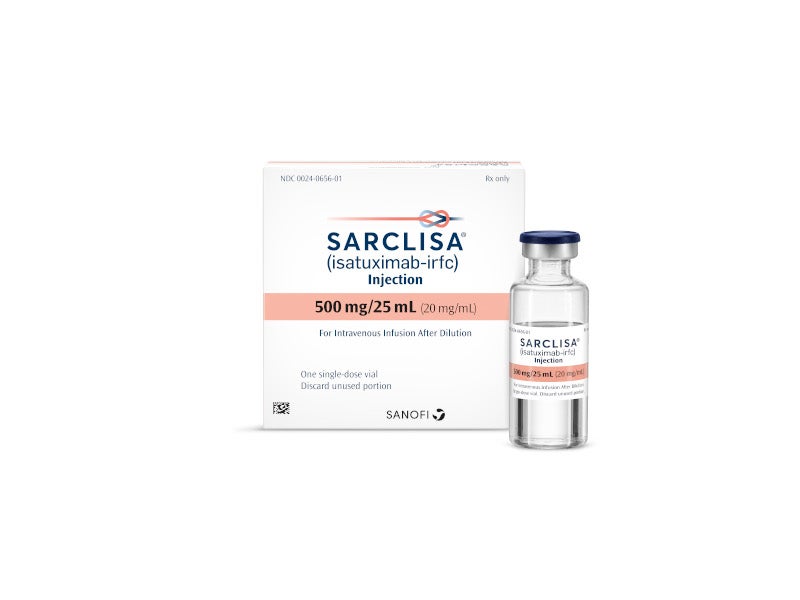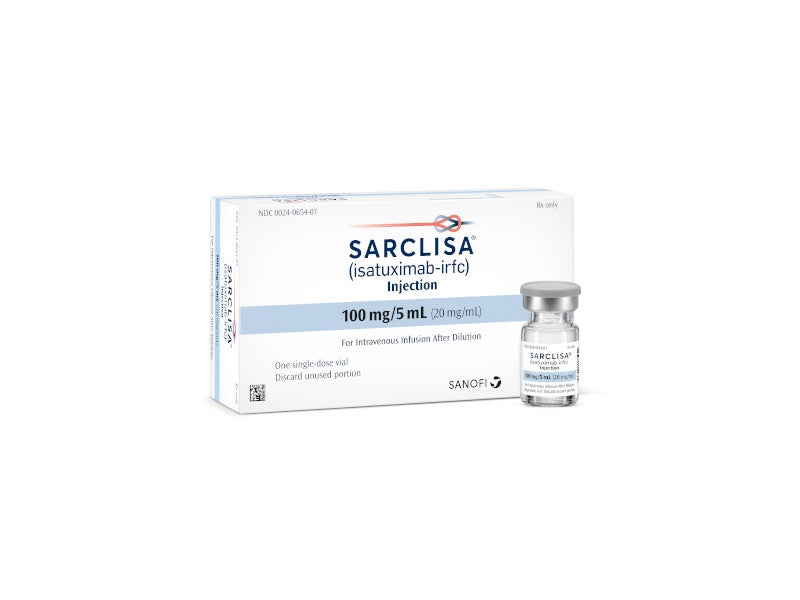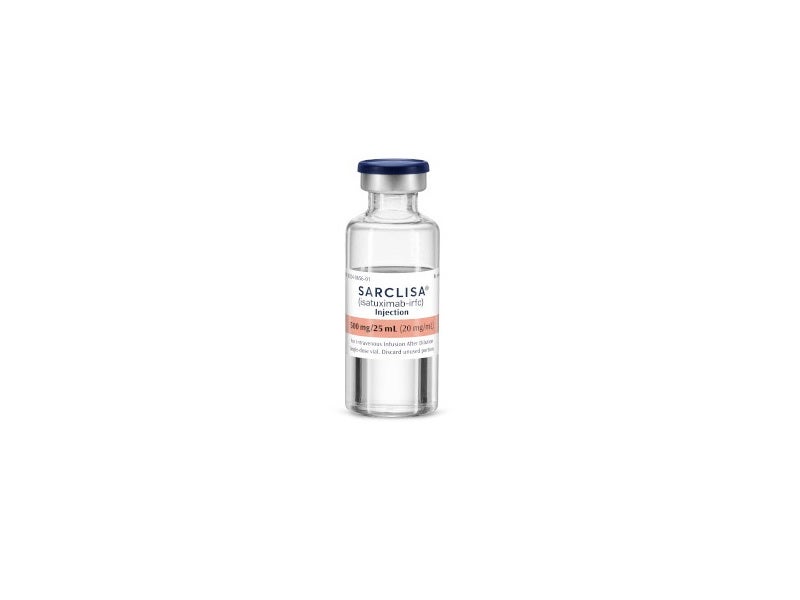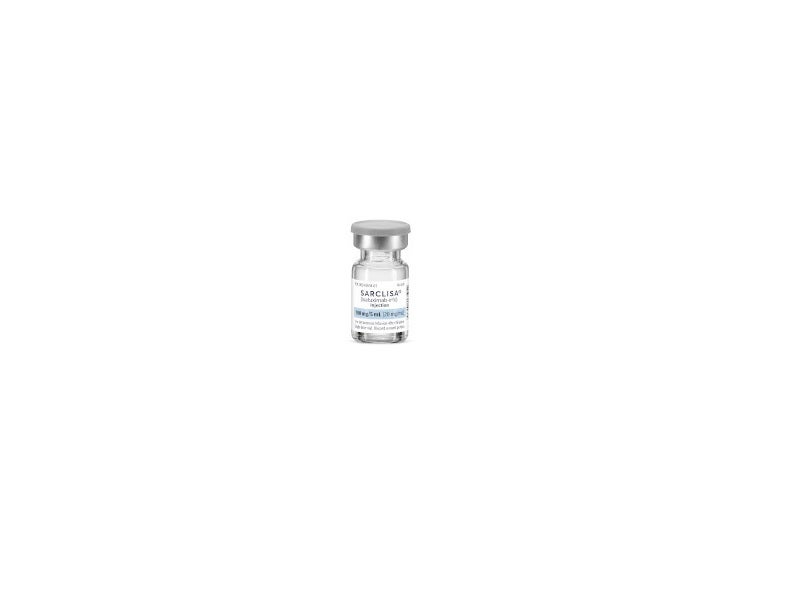Sarclisa® (isatuximab) is a monoclonal antibody indicated, in combination with pomalidomide and dexamethasone (pom-dex), for the treatment of multiple myeloma in adult patients who have received at least two previous therapies, including lenalidomide and a proteasome inhibitor.
Sarclisa has distinguished itself as the first anti-CD38 therapy to be combined with bortezomib, lenalidomide, and dexamethasone (VRd), demonstrating a significant 40% reduction in the risk of disease progression or mortality when compared to VRd alone in patients with newly diagnosed multiple myeloma (NDMM) not eligible for transplant.
Developed by Sanofi-Aventis, Sarclisa is available in single-dose vials with dosage strengths comprising 100mg/5ml and 500mg/25ml for intravenous injection.
Regulatory approvals for Sarclisa
In September 2024, the US Food and Drug Administration (FDA) approved the use of Sarclisa alongside VRd, as a first-line treatment for adult patients with NDMM who are ineligible for autologous stem cell transplant (ASCT). The approval was based on findings from the IMROZ Phase III clinical trial.
Previously, in April 2021, the European Commission (EC) approved Sarclisa for use with carfilzomib and dexamethasone (Kd) for adults who have relapsed multiple myeloma and have undergone at least one prior treatment. This constituted the second EC endorsement for Sarclisa as part of a standard care regimen within less than a year.
The EC’s first approval for Sarclisa, paired with pom-dex, came in June 2020, targeting adults with relapsed refractory multiple myeloma (r/r MM).
The FDA approved Sarclisa in combination with Kd for patients with r/r MM in March 2021, based on the Phase III IKEMA pivotal trial. The regimen has decreased the risk of disease progression or death by 45% versus the standard of care in patients who had relapsed after one to three previous therapies.
Sarclisa received the first approval, in combination with pom-dex, from the FDA for the treatment of adult patients with r/r MM in March 2020.
Additionally, Sarclisa (isatuximab) has been recognised with orphan drug designation by both the FDA and the European Medicines Agency (EMA), reflecting its potential in treating rare diseases.
Besides the US and Europe, Sarclisa is approved in Switzerland, Canada, Australia, Japan, Russia, the UAE, South Korea, Taiwan and Brazil in combination with pom-dex to treat certain adults with r/r MM.
Multiple myeloma causes and symptoms
Also referred to as myeloma of plasma cells, multiple myeloma occurs in plasma cells, a type of white blood cell found in the bone marrow. It causes malignant plasma cells to accumulate in the bone marrow, resulting in cell proliferation.
The disease affects more than 130,000 patients in the US while approximately 32,000 people in the US are diagnosed with multiple myeloma every year. Approximately 40,000 new cases of multiple myeloma occur every year in Europe.
Common symptoms of the disease are bone tenderness, fatigue, loss of appetite, shortness of breath, nausea, weight loss, constipation, frequent urination, bleeding gums and excessive thirst.
Sarclisa’s mechanism of action
Isatuximab is an IgG1-derived monoclonal antibody that selectively binds to the multiple myeloma cell receptor, CD38, and causes programmed tumour cell death (apoptosis). CD38 is expressed on both haematopoietic and tumour cells but is highly expressed on malignant plasma cells in multiple myeloma.
Isatuximab activates the immunomodulatory effect such as antibody-dependent cellular phagocytosis (ADCP), complement-dependent cytotoxicity (CDC) and antibody-dependent cell-mediated cytotoxicity (ADCC).
Isatuximab also inhibits the ADP-ribosyl cyclase activity of CD38. It can activate natural killer (NK) cells in the absence of CD38-positive target tumour cells and inhibits CD38-positive T-regulatory cells.
Isatuximab, in combination with pomalidomide, increases ADCC activity and kills the tumour cells.
Clinical trials on Sarclisa
The initial FDA approval of Sarclisa, in combination with pom-dex, comes from the pivotal ICARIA-MM clinical trial.
ICARIA-MM is a randomised, multi-centre, open-label, two-arm and Phase III study involving 307 patients.
Patients, at random (1:1), received either Sarclisa in combination with pomalidomide and low-dose dexamethasone or pomalidomide and low-dose dexamethasone.
Both groups received treatment for 28-day cycles until the progression of the disease or unacceptable toxicity. A dose of 10mg/kg was administered as an intravenous infusion weekly in the first cycle and every two weeks thereafter.
The dose of pomalidomide was 4mg orally once daily from day 1 to day 21 during each 28-day cycle. A 40mg dose of dexamethasone was given (20mg for patients aged over 75 years) orally or intravenously on days 1, 8, 15, and 22 during each 28-day cycle.
The primary endpoint was based on progression-free survival (PFS), the duration when a patient stays alive without progression of cancer, while the secondary endpoint was the overall response rate (ORR).
Patients treated with Sarclisa in combination with pomalidomide and low-dose dexamethasone experienced a 40% reduction in the risk of disease progression or death when compared to patients who received pom-dex.
In addition, patients who received Sarclisa in combination with pomalidomide and low-dose dexamethasone had an ORR of 60.4% versus the patients who only received pomalidomide and low-dose dexamethasone had an ORR of 35.3%.
The most common adverse reactions observed in the patients during the trial were anaemia, lymphopenia, thrombocytopenia, neutropenia, pneumonia, diarrhoea, infusion-related reactions and upper respiratory tract infection.







